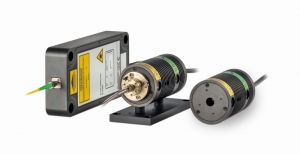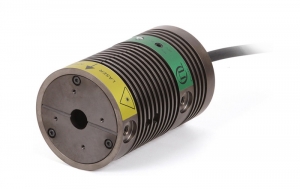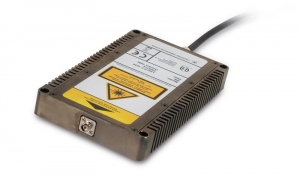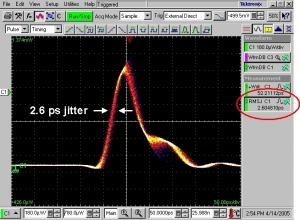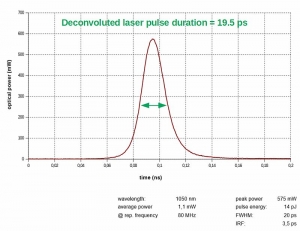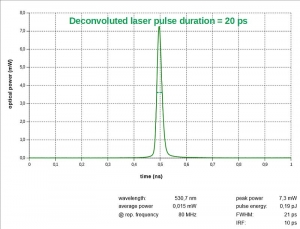Picosecond Pulsed Sources
LDH Series
Picosecond Laser Diode Heads for PDL 800-D/PDL 810/PDL 828
- NEW: PIE-ALEX ready fast-switched laser heads – best controlled via Sepia PDL 828. Watch video
- Wavelengths between 375 and 1990 nm
- Pulse widths as short as 20 ps (FWHM)
- Adjustable (average) power up to 50 mW
- Repetition rate from single shot to 80 MHz
- Optional dual mode: pulsed and CW operation
- Collimating optics, optional fiber coupling and peltier cooling
 The LDH Series laser heads are ideally suited for any application that requires picosecond pulses with variable repetition rates. Since we use a wide variety of laser diode types for our LDH laser heads, we can offer a broad range of wavelengths, power values, and spectral widths. Each laser head includes control electronics specially matched to the diode and collimating optics. Different types of optical fibers can also be fitted to laser output.
The LDH Series laser heads are ideally suited for any application that requires picosecond pulses with variable repetition rates. Since we use a wide variety of laser diode types for our LDH laser heads, we can offer a broad range of wavelengths, power values, and spectral widths. Each laser head includes control electronics specially matched to the diode and collimating optics. Different types of optical fibers can also be fitted to laser output.
Short pulse durations
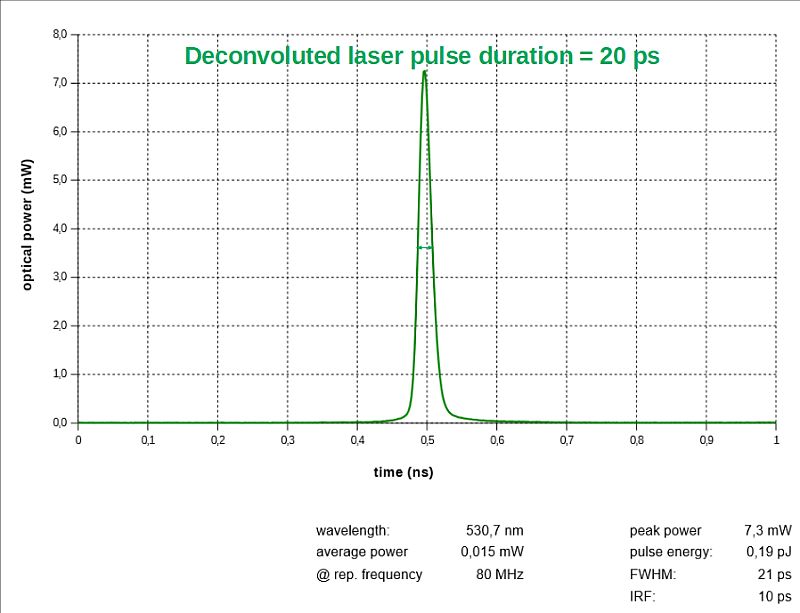 Most LDH laser heads can generate pulses with a temporal width ranging typically between 40 and 120 ps (FWHM), while some individual diodes can achieve pulse widths down to 20-30 ps (selectable on request). Temporal pulse width depends on the laser diode and on the power level at which the laser head is being operated (i.e., an optimal pulse width is reached above the laser threshold and can broaden with increasing power).
Most LDH laser heads can generate pulses with a temporal width ranging typically between 40 and 120 ps (FWHM), while some individual diodes can achieve pulse widths down to 20-30 ps (selectable on request). Temporal pulse width depends on the laser diode and on the power level at which the laser head is being operated (i.e., an optimal pulse width is reached above the laser threshold and can broaden with increasing power).
Adjustable average power of several mW
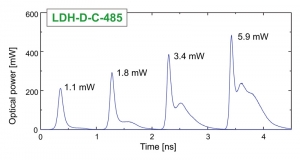 Laser heads of the LDH Series are designed to produce nearly constant pulse energy at a given intensity setting. The commonly achieved pulse energies are typically around a few tens of pJ. At repetition rates of 40 or 80 MHz, this corresponds to average output powers of several mW. Note that with increased output power, the diodes temporal pulse profile will always broaden and might show additional peaks or shoulders.
Laser heads of the LDH Series are designed to produce nearly constant pulse energy at a given intensity setting. The commonly achieved pulse energies are typically around a few tens of pJ. At repetition rates of 40 or 80 MHz, this corresponds to average output powers of several mW. Note that with increased output power, the diodes temporal pulse profile will always broaden and might show additional peaks or shoulders.
By varying the total number of carriers (i.e., the driving current) in the diode it is possible to change the output power of the diode. However, a higher pulse power, i.e., a higher injected current leads to additional oscillations inside the laser diode. These oscillations can be seen as 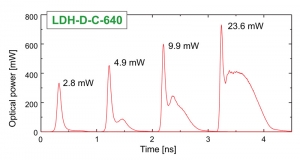 additional peaks or shoulders in the temporal pulse profile. As a consequence, an increased output power of the diode always results in an increased pulse width and a non-uniform temporal pulse shape. "Clean" and near symmetrical pulses can only be achieved close to the lasing threshold.
additional peaks or shoulders in the temporal pulse profile. As a consequence, an increased output power of the diode always results in an increased pulse width and a non-uniform temporal pulse shape. "Clean" and near symmetrical pulses can only be achieved close to the lasing threshold.
Repetition rates up to 80 MHz
When operated in conjunction with a laser driver from the PDL Series, all heads from the LDH Series are capable of repetition rates ranging from 1 Hz to several tens of MHz. Depending on the diode used, maximum rates of 40 and 80 MHz can be achieved for blue (with wavelengths shorter than 530 nm) and red emitting laser heads, respectievely.
Pulsed and CW operation
LDH-D laser heads can be operated in either pulsed or cw mode. When run in cw mode, they can reach optical output powers up to 200 mW, while power in pulsed mode is identical to that of an LDH-P laser head with the same emission wavelength. Note that dual operation mode is only available when using a PDL 800-D, Sepia PDL 810 or PDL 828 “Sepia II” laser driver.
Fiber coupling and combiner
The laser heads of the LDH Series can be optionally coupled into a variety of optical fibers (multi-mode, single mode, or polarization maintaining single mode) via different connector types. We recommend FC/APC connectors for most applications, since they prevent back reflections that can interfere with laser stability. For details see our solutions for fiber coupling.
Furthermore, up to 5 laser heads of the LDH Series can be combined into a single delivery fiber within our Laser Combining Unit (LCU).
General specifications
| Beam parameters3 | |
|---|---|
| Optics focus length | f' = 4.5 mm (Typ. for LDH-P/D-C-xxx) f' = 9.0 mm (Typ. for LDH-D-TA-xxx) |
| Numerical aperture | 0.55 |
| Typical divergence (with optics) | Theta parallel Typ. 0.11 mrad Theta perpendicular Typ. 0.32 mrad |
| Beam shape | Elliptical shape, typ. dimensions 1.5 × 3.5 mm |
| Polarization | typ. linear, perpendicular to the longer axis of the elliptical beam1 |
| Polarization Extinction Ratio (PER) | typ. > 1:10 (> 10 dB) |
| Side mode suppression ratio (SMSR) | typ. < 0.01 |
| Cooling | |
| Peltier cooling stability | better than 1 K for ambient temperature between 15 and 30 °C |
| Dimensions | |
| Cooled | 62 × 100 mm (diameter × length) |
| Cooled with fiber coupling | 62 × 132 mm (diameter × length) |
| Cooled D-TA type | 68 × 148 mm (diameter × length) |
| "F-type" with FC/APC connector | 200 × 100 × 35 mm (l × w × h) |
| Spectral width2 | |
| Wavelengths < 900 nm | approx. 2 to 8 nm |
| Wavelengths > 900 nm | approx. 10 to 20 nm |
| CW operation | < 1 nm |
| Power stability (cooled) | |
| 12 hours, Delta T (ambient) < 3 K | 1 % RMS, 3 % peak to peak |
1 a few exceptions to this behavior might occur
2 narrower bandwidth might be available on request
3 the values of beam parameter are typical values. Some fluctuation may occur. In particular the beam divergence can be larger for multimode diode laser diode head (LDH-P/D-C-XXXM)

Pulse-to-pulse jitter
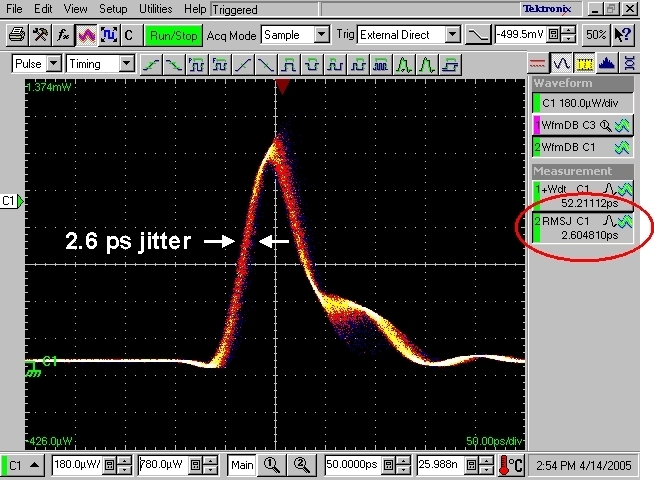 The image on the right shows a typical measurement result of the pulse-to-pulse jitter. In this case the measurement result is 2.6 ps.
The image on the right shows a typical measurement result of the pulse-to-pulse jitter. In this case the measurement result is 2.6 ps.
All Information given here is reliable to our best knowledge. However, no responsibility is assumed for possible inaccuracies or omissions. Specifications and external appearances are subject to change without notice.
The following table lists the pulse parameters and power values of the available wavelengths of the LDH Series (available between 266 and 530 nm with max. repetition rate of 40 MHz and between 530 and 2000 nm with max. repetition rate of 80 MHz). The two power adjustment levels specified here refer to the same laser head. These levels can be adjusted using the corresponding driver of the PDL Series. The 'Low' adjustment is the best choice for shortest pulses and is usually reached close to the lasing threshold. The 'High' adjustment is used to achieve highest pulse power at moderate pulse length and corresponds to the maximum intensity setting of the driver. Dual mode laser head (LDH-D Series, pulsed and CW operation) can only be controlled by the PDL 800-D or PDL 828 "Sepia II" laser driver. These laser heads have a spectral width of a few nm. Special selected laser heads with narrow spectral bandwidth can also be provided.
The table below is regularly updated based on data from recently manufactured laser heads. Other specifications such as shorter pulse widths or higher powers might be possible depening on the performance of diodes in stock. Please contact us for more information.
| Wavelength (± 10) [nm] |
Type (LDH-) |
Pulse1 (FWHM) [ps] |
Max rep. rate [MHz] |
High avg. power2 [mW] |
Low avg. power3 [mW] |
CW power [mW] |
| 266 (± 3) | P-FA-2666 | Please refer to the LDH-FA Series page | ||||
| 355 (± 3) | P-FA-3556 | Please refer to the LDH-FA Series page | ||||
| 375 (± 5) | P-C-375 | < 90 | 40 | 2.0 | 0.6 | -- |
| P-C-375B | < 60 | 40 | 5.0 | 0.8 | -- | |
| D-C-375 | < 60 | 40 | 5.0 | 0.8 | 40 | |
| P-C-375M | < 90 | 40 | 10.0 | 2.5 | -- | |
| D-C-375M | < 90 | 40 | 10.0 | 2.5 | 50 | |
| 395 | P-C-390 | < 70 | 40 | 5.0 | 1.0 | -- |
| D-C-390 | < 70 | 40 | 5.0 | 1.0 | 30 | |
| 405 | P-C-405 | < 50 | 80 | 4.0 | 0.8 | -- |
| P-C-405B | < 50 | 40 | 3.0 | 1.0 | -- | |
| D-C-405 | < 50 | 40 | 3.0 | 1.0 | 50 | |
| D-C-405S | < 50 | 40 | 3.0 | 1.0 | 50 | |
| P-C-405M | < 90 | 40 | 25.0 | 10.0 | -- | |
| CPDL-Q-405 | Please refer to the OEM lasers page | |||||
| 420 | P-C-420 | < 70 | 40 | 5.0 | 0.5 | -- |
| D-C-420 | < 70 | 40 | 5.0 | 0.5 | 30 | |
| 440 | P-C-440 | < 80 | 40 | 2.0 | 0.4 | -- |
| P-C-440B | < 70 | 40 | 4.0 | 1.0 | -- | |
| D-C-440 | < 70 | 40 | 4.0 | 1.0 | 50 | |
| D-C-440S | < 80 | 40 | 4.0 | 0.8 | 50 | |
| P-C-440M | < 100 | 40 | 25.0 | 10.0 | -- | |
| D-C-440M | < 100 | 40 | 25.0 | 10.0 | 200 | |
| 450 | P-C-450 | < 100 | 40 | 2.0 | 0.5 | -- |
| P-C-450B | < 70 | 40 | 5.0 | 0.7 | -- | |
| D-C-450 | < 70 | 40 | 5.0 | 0.7 | 10 | |
| P-C-450M | < 110 | 40 | 20.0 | 1.0 | -- | |
| D-C-450M | < 110 | 40 | 20.0 | 1.0 | 200 | |
| CPDL-Q-450 | Please refer to the OEM lasers page | |||||
| 470 | P-C-470 | < 80 | 40 | 3.0 | 0.6 | -- |
| P-C-470B | < 70 | 40 | 4.0 | 0.8 | -- | |
| D-C-470 | < 70 | 40 | 4.0 | 0.8 | 60 | |
| D-C-470S | < 70 | 40 | 4.0 | 0.8 | 60 | |
| P-C-470M | < 120 | 40 | 20.0 | 8.0 | -- | |
| D-C-470M | < 120 | 40 | 20.0 | 8.0 | 200 | |
| 488 (± 3) | P-C-488 | < 140 | 40 | 4.0 | 0.7 | -- |
| D-C-488 | < 140 | 40 | 4.0 | 0.7 | 40 | |
| 485 | P-C-485 | < 170 | 40 | 2.0 | 0.4 | -- |
| P-C-485B | < 140 | 40 | 5.0 | 0.7 | -- | |
| D-C-4854 | < 100 | 40 | 5.0 | 0.9 | 50 | |
| D-C-485S4 | < 120 | 40 | 5.0 | 0.7 | 50 | |
| CPDL-Q-488 | Please refer to the OEM lasers page | |||||
| 500 | P-C-500 | < 130 | 40 | 2.0 | 0.5 | -- |
| P-C-500B | < 100 | 40 | 5.0 | 0.7 | -- | |
| D-C-500 | < 100 | 40 | 5.0 | 0.7 | 40 | |
| 510 | P-C-510 | < 130 | 40 | 2.0 | 0.3 | -- |
| P-C-510B | < 130 | 40 | 4.0 | 0.6 | -- | |
| D-C-5104 | < 130 | 40 | 4.0 | 0.6 | 40 | |
| D-C-510S4 | < 110 | 40 | 4.0 | 0.6 | 40 | |
| 515 (± 3) | P-FA-515L6 | Please refer to the LDH-FA Series page | ||||
| CPDL-Q-515 | Please refer to the OEM lasers page | |||||
| P-C-520B | < 170 | 40 | 4.0 | 1.3 | -- | |
| D-C-5204 | < 170 | 40 | 4.0 | 1.3 | 40 | |
| 520 | P-C-520M | < 160 | 40 | 25.0 | 6.0 | -- |
| 532 (± 3) | P-FA-530B/L/XL6 | Please refer to the LDH-FA Series page | ||||
| D-TA-5306 | < 80 | 80 | 0.7 | 0.3 | 10 | |
| D-TA-530B6 | < 80 | 80 | 1.1 | 0.5 | 20 | |
| 557 (± 3) | P-FA-5606 | Please refer to the LDH-FA Series page | ||||
| 561 (± 3) | D-TA-5606 | < 80 | 80 | 0.5 | 0.3 | 5 |
| D-TA-560B6 | < 80 | 80 | 0.7 | 0.5 | 20 | |
| 594 (± 3) | D-TA-5956 | < 100 | 80 | 0.3 | 0.2 | 5 |
| D-TA-595B6 | < 100 | 80 | 0.5 | 0.4 | 5 | |
| 596 (± 3) | P-FA-595B6 | Please refer to the LDH-FA Series page | ||||
| 635 | P-C-635M | < 120 | 80 | 20.0 | 4.0 | -- |
| D-C-635M | < 120 | 80 | 20.0 | 4.0 | 100 | |
| 640 | P-C-640B | < 90 | 80 | 20.0 | 2.0 | -- |
| D-C-640 | < 90 | 80 | 20.0 | 3.0 | 50 | |
| D-C-640S | < 90 | 80 | 20.0 | 2.0 | 50 | |
| CPDL-Q-640 | Please refer to the OEM lasers page | |||||
| 655 | P-C-650 | < 90 | 80 | 6.0 | 0.9 | -- |
| D-C-650 | < 90 | 80 | 6.0 | 0.9 | 10 | |
| 660 | P-C-660 | < 90 | 80 | 10.0 | 1.0 | -- |
| D-C-660 | < 90 | 80 | 10.0 | 1.0 | 30 | |
| 665 | P-C-670B | < 90 | 80 | 4.0 | 0.7 | -- |
| D-C-670B | < 90 | 80 | 4.0 | 0.7 | 15 | |
| 670 | P-C-670 | < 70 | 80 | 2.0 | 0.5 | -- |
| D-C-670 | < 70 | 80 | 2.0 | 0.7 | 3 | |
| 685 | P-C-690 | < 70 | 80 | 8.0 | 1.0 | -- |
| D-C-690 | < 70 | 80 | 8.0 | 1.0 | 20 | |
| 705 | P-C-705 | < 70 | 80 | 10.0 | 2.0 | -- |
| D-C-705 | < 70 | 80 | 10.0 | 2.0 | 20 | |
| 730 | P-C-730 | < 70 | 80 | 6.0 | 2.0 | -- |
| D-C-730 | < 70 | 80 | 6.0 | 2.0 | 15 | |
| 760 (± 3) | P-C-N-760 | See "narrow bandwith" table below | ||||
| 766 (± 3) | P-FA-765XL6 | Please refer to the LDH-FA Series page | ||||
| 775 (± 3) | P-FA-775XL6 | Please refer to the LDH-FA Series page | ||||
| 780 | P-C-780 | < 70 | 80 | 10.0 | 1.0 | -- |
| D-C-780 | < 70 | 80 | 10.0 | 1.0 | 40 | |
| 805 | P-C-810 | < 110 | 80 | 10.0 | 1.0 | -- |
| D-C-810 | < 110 | 80 | 10.0 | 1.0 | 50 | |
| P-C-810M | < 90 | 80 | 30.0 | 3.0 | -- | |
| D-C-810M | < 90 | 80 | 30.0 | 3.0 | 100 | |
| 830 | P-C-830 | < 70 | 80 | 8.0 | 0.3 | -- |
| D-C-830 | < 70 | 80 | 8.0 | 0.3 | 20 | |
| P-C-830M | < 90 | 80 | 30.0 | 10.0 | -- | |
| D-C-830M | < 90 | 80 | 30.0 | 10.0 | 100 | |
| 840 | P-C-840 | < 80 | 80 | 4.0 | 0.5 | -- |
| D-C-840 | < 80 | 80 | 4.0 | 0.5 | 30 | |
| 852 (± 3) | P-C-N-850 | See "narrow bandwith" table below | ||||
| 850 | D-C-850 | < 90 | 80 | 10.0 | 3.0 | 50 |
| 905 | P-C-905 | < 90 | 80 | 8.0 | 1.5 | -- |
| D-C-905 | < 90 | 80 | 8.0 | 1.5 | 50 | |
| 940 | P-C-940 | < 90 | 80 | 5.0 | 1.4 | -- |
| D-C-940 | < 90 | 80 | 5.0 | 1.4 | 50 | |
| 975 | P-C-980 | < 80 | 80 | 6.0 | 1.8 | -- |
| 975 | D-C-980 | < 80 | 80 | 6.0 | 1.8 | 50 |
| 976 | P-F-980 | < 110 | 80 | 25.0 | 7.0 | -- |
| D-F-980 | < 110 | 80 | 25.0 | 7.0 | 100 | |
| 980 | P-C-980MB5 |
< 6000 | 80 | 380.0 | -- | -- |
| 1025 | P-F-1030 | < 90 | 80 | 10.0 | 2.0 | -- |
| 1062 (± 3) | P-C-N-1064 | See "narrow bandwith" table below | ||||
| 1062 (± 3) | D-C-N-1064 | See "narrow bandwith" table below | ||||
| 1063 (± 3) | P-FA-1060/XL6 | Please refer to the LDH-FA Series page | ||||
| 1080 | P-C-1080 | < 50 | 80 | 4.0 | 2.5 | -- |
| D-C-1080 | < 50 | 80 | 4.0 | 2.5 | 30 | |
| 1120 | P-C-1120 | < 90 | 80 | 5.0 | 2.5 | -- |
| D-C-1120 | < 90 | 80 | 5.0 | 2.5 | 20 | |
| 1310 (± 20) | P-C-1310 | < 50 | 80 | 2.0 | 0.1 | -- |
| D-C-1310 | < 50 | 80 | 2.0 | 0.1 | 5 | |
| 1532 to 1560 (± 3) | P-FA-1530/XL6 | Please refer to the LDH-FA Series page | ||||
| 1550 (± 30) | P-C-1550 | < 50 | 80 | 1.0 | 0.02 | -- |
| 1550 (± 20) | D-C-1550 | < 40 | 80 | 1.0 | 0.05 | 2.5 |
| 1990 (± 40) | P-F-1990 | < 120 | 80 | 0.3 | 0.1 | -- |
1 Shortest pulse width at min intensity setting above laser threshold. Possible pulse broadening at high intensity settings.
Pulses are deconvoluted with 30 ps detection IRF. Shorter pulse widths are available on demand.
2 Average optical power at max repetition rate and max intensity setting.
3 Average optical power at max repetition rate and min intensity setting above laser threshold.
4 Different coupling efficiency into optical fibers for pulsed and CW operation due to astigmatism and possible wavelength shift. The coupling is optimized for pulsed operation as standard.
5 The max sustained repetition rate without extra cooling is 40 MHz. 80 MHz is meant to be used in burst mode with duty
cycle of max 50% for e.g. upconversion application. A sustained operation at 80 MHz is possible with external fan cooling.
Without external cooling, possible overheating may occur after a few minutes, leading to safety shut-off.
6 Amplified laser heads are excluded from the 5-year limited warranty.
Naming scheme of the LDH Series laser heads

Description:
Option "C": Laser head with thermoelectric cooler, mandatory for some laser heads, optional for all other laser heads.
Option "S": NEW ns Fast-switched capability for CW mode. PIE-ALEX ready – best controlled via Sepia PDL 828
Option "M": Transversal multi mode structure, reduced coupling efficiency into single mode fibers, not suited for microscopy applications
Option "F": Laser head emits a divergent beam from FC/APC fiber output connector.
On request: narrow spectral bandwidth
The given specification are for information only, possible changes may occur.
| Wavelength | |||||||
| Central [nm] |
Variation [nm] |
Type4 (LDH-) |
Linewidth (FWHM) [nm] |
Pulse1 (FWHM) [ps] |
Max rep. rate [MHz] |
Low avg. power2 [mW] |
High avg. power3 [mW] |
| 760 | ±3 | P-C-N-760 | < 0.2 | < 110 | 80 | 0.9 | 6.0 |
| 782 | ±3 | P-C-N-780 | On request | ||||
| 852 | ±3 | P-C-N-850 | < 0.3 | < 100 | 80 | 1.5 | 9.0 |
| 1062 | ±3 | P-C-N-1064 | < 1 | < 130 | 80 | 0.8 | 10.0 |
| 1062 | ±3 | D-C-N-1064 | < 1 | < 130 | 80 | 0.8 | 10.0 |
| 1063 | ±3 | P-F-N-1064 | < 0.5 | < 100 | 80 | 0.9 | 10.0 |
| 1275 | ±7 | P-C-N-1310 | < 0.5 | < 40 | 80 | 0.03 | 1.3 |
| 1300 | ±7 | P-C-N-1310 | < 0.5 | < 40 | 80 | 0.03 | 1.3 |
| 1310 | ±7 | P-C-N-1310 | < 0.5 | < 40 | 80 | 0.03 | 1.3 |
| 1325 | ±7 | P-C-N-1310 | < 0.5 | < 40 | 80 | 0.03 | 1.3 |
| 1349 | ±7 | P-C-N-1310 | < 0.5 | < 40 | 80 | 0.03 | 1.3 |
| 1510 | ±3 | P-C-N-1550 | <0.2 | < 40 | 80 | 0.05 | 1.3 |
| 1530 | ±3 | P-C-N-1550 | < 0.2 | < 40 | 80 | 0.05 | 1.3 |
| 1530 | ±3 | P-C-N-1550 | < 0.2 | < 40 | 80 | 0.05 | 1.3 |
| 1550 | ±3 | P-C-N-1550 | < 0.2 | < 40 | 80 | 0.05 | 1.3 |
| 1550 | ±3 | P-F-N-1550 | < 0.5 | < 70 | 80 | 0.1 | 2.5 |
| 1570 | ±3 | P-C-N-1550 | < 0.2 | < 40 | 80 | 0.05 | 1.3 |
| 1590 | ±3 | P-C-N-1550 | < 0.2 | < 40 | 80 | 0.05 | 1.3 |
| 1610 | ±3 | P-C-N-1550 | < 0.2 | < 40 | 80 | 0.05 | 1.3 |
| Available upon request: 763, 795, 937, 1083 nm (± 3 nm) | |||||||
1 Shortest pulse width at min intensity setting above laser threshold. Possible pulse broadening at high intensity settings. The instrument response function of 30 ps is deconvoluted. Shorter pulse widths are available on demand.
2 Average optical power at max repetition rate and max intensity setting.
3 Average optical power at max repetition rate and min intensity setting above laser threshold.
4 LDH-D-C-N types including CW mode are available as well.

Other wavelength as well as wavelength selection are available upon special request. All measurements shown may be subject to a 10% callibration error.
Each laser head undergoes an extensive burn-in test to ensure long-term stability and is shipped with a comprehensive set of test data. This test data is kept in our database, which already holds records of more than 18 years.
All Information given here is reliable to our best knowledge. However, no responsibility is assumed for possible inaccuracies or omissions. Specifications and external appearances are subject to change without notice.
The picosecond pulsed diode lasers of the LDH Series can be used for various applications, where short pulses with high and variable repetition rates as well as stable pulse energies are important, such as:
- Time-Resolved Fluorescence
- Fluorescence Lifetime Imaging (FLIM)
- Phosphorescence Lifetime Imaging (PLIM)
- Fluorescence Correlation Spectroscopy (FCS)
- Fluorescence Lifetime Correlation Spectroscopy (FLCS)
- Foerster Resonance Energy Transfer (FRET)
- Stimulated Emission Depletion Microscopy (STED)
- Dual Focus Fluorescence Correlation Spectroscopy (2fFCS)
- Pulsed Interleaved Excitation (PIE)
- Fluorescence Anisotropy (Polarization)
- Singlet Oxygen
- Laser Cutting/Ablation
- Time-Resolved Photoluminescence (TRPL)
- TRPL Imaging
- Lanthanide Upconversion
- Laser Seeding
- LIDAR/Ranging/SLR
- Antibunching
- Diffuse Optical Tomography and Imaging
- Single Molecule Spectroscopy / Detection
- Single Photon Generation
- Time response characterization of opto-electronic devices
The following documents are available for download:
- Datasheet LDH Series
- Brochure about PicoQuant's laser products
- Design LDH-P/D-C Series
- Design LDH-F Series
- Appendix LDH-D-C-xxxS Laser Delivery Report
Latest 10 publications referencing Pulsed Diode Lasers (PDL Series, LDH-Series, LDH-FA Series)
The following list is an extract of 10 recent publications from our bibliography that either bear reference or are releated to this product in some way. Do you miss your publication? If yes, we will be happy to include it in our bibliography. Please send an e-mail to info@picoquant.com containing the appropriate citation. Thank you very much in advance for your kind co-operation.


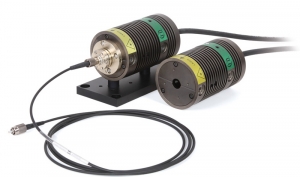
 Get in touch
Get in touch
